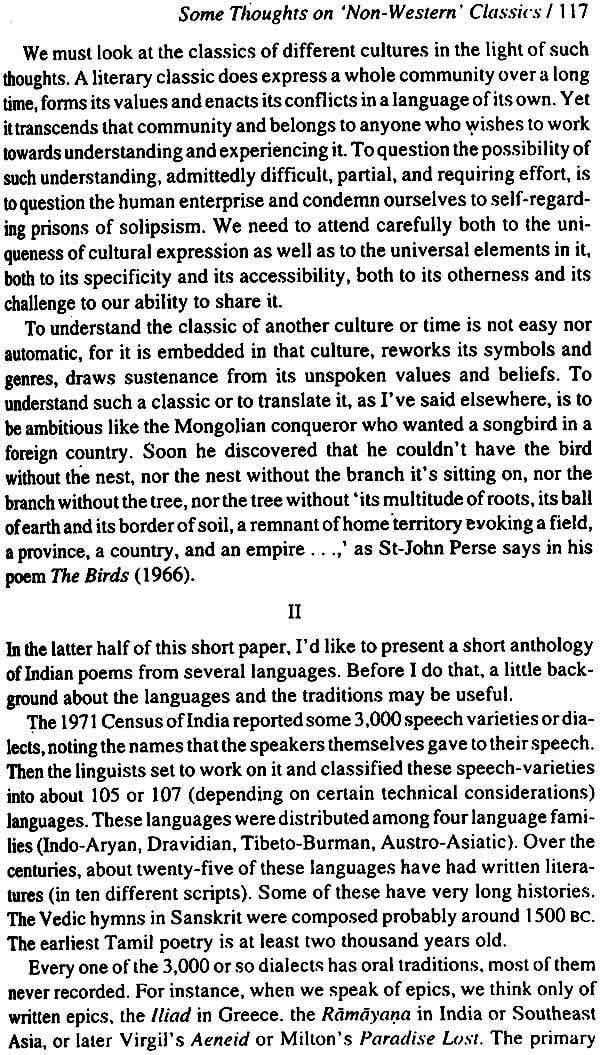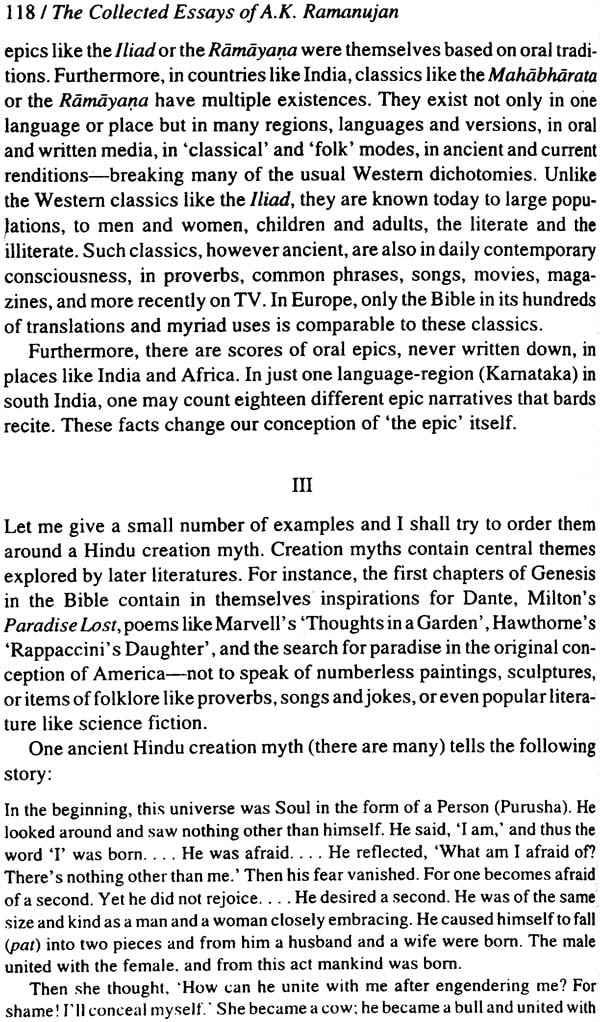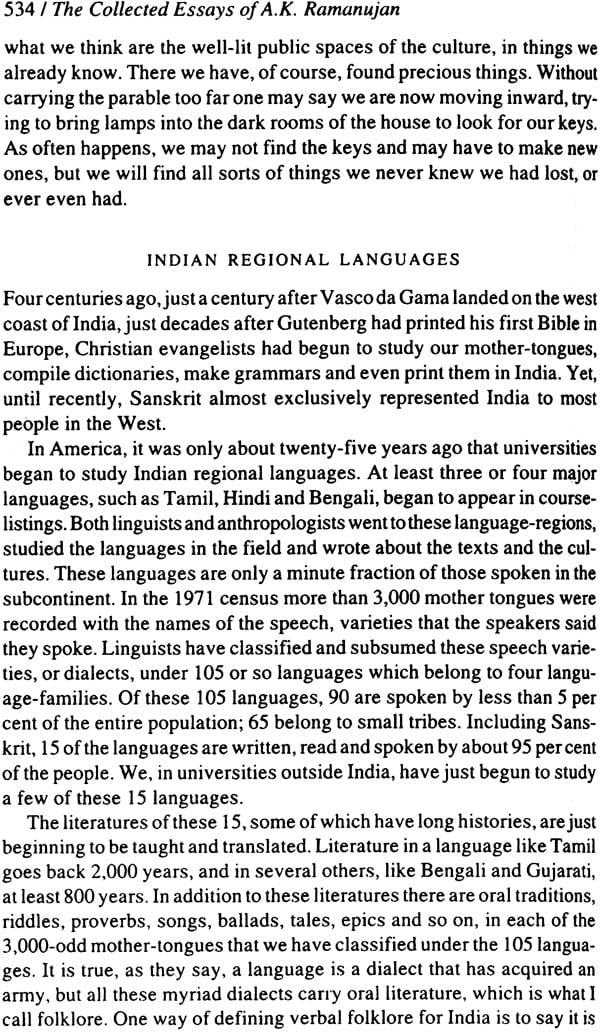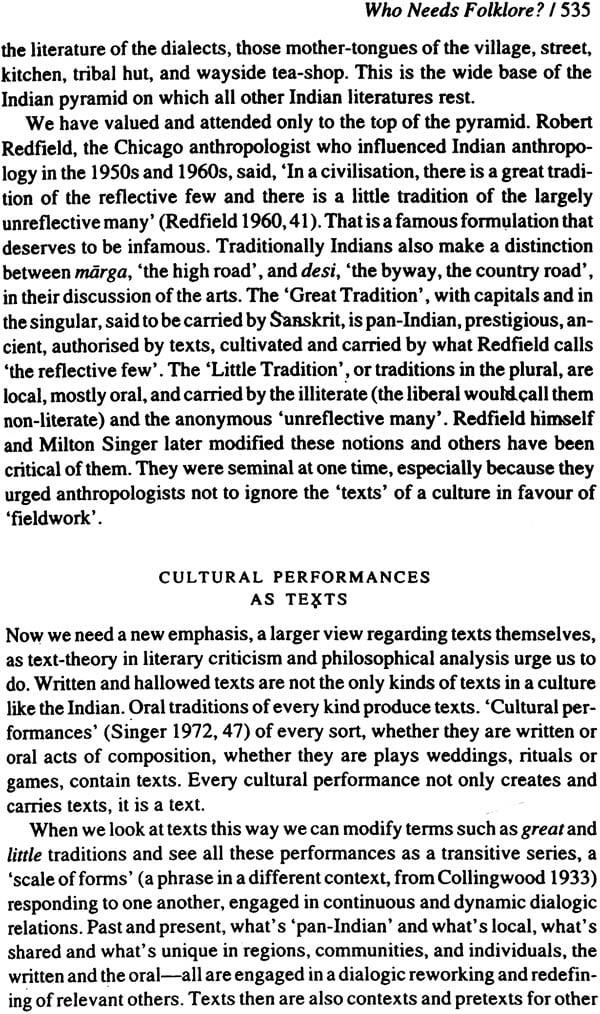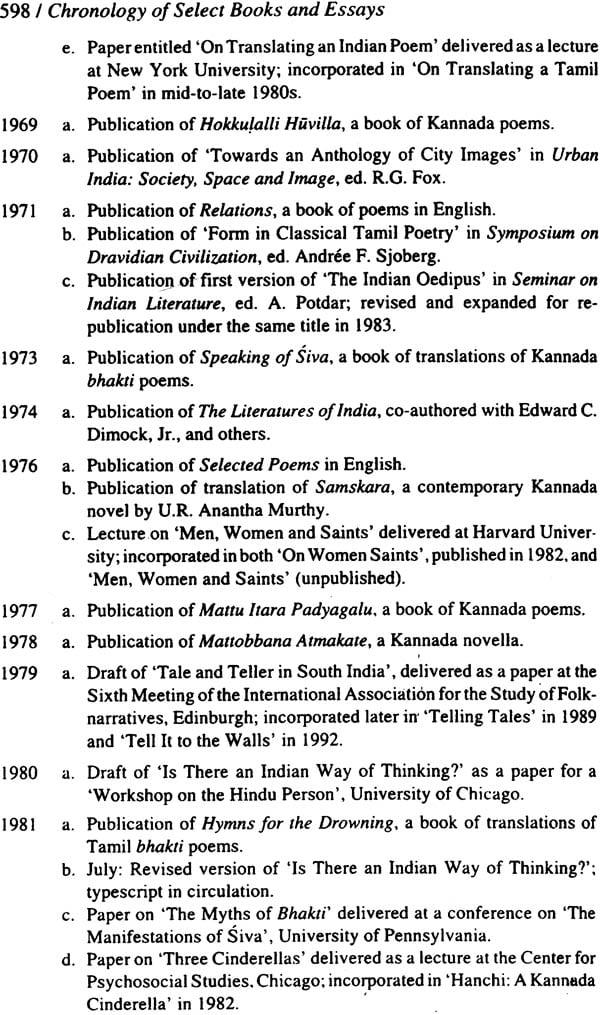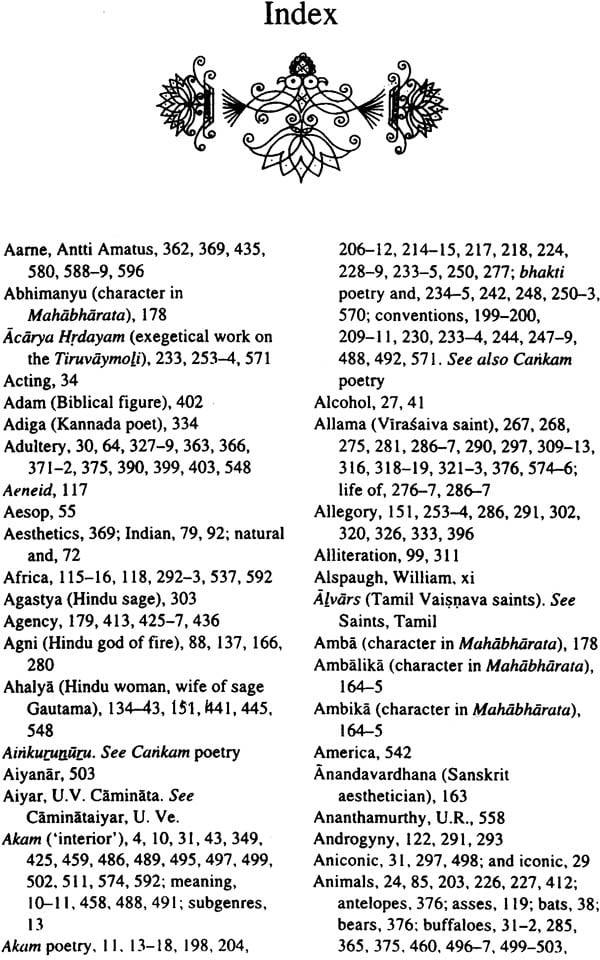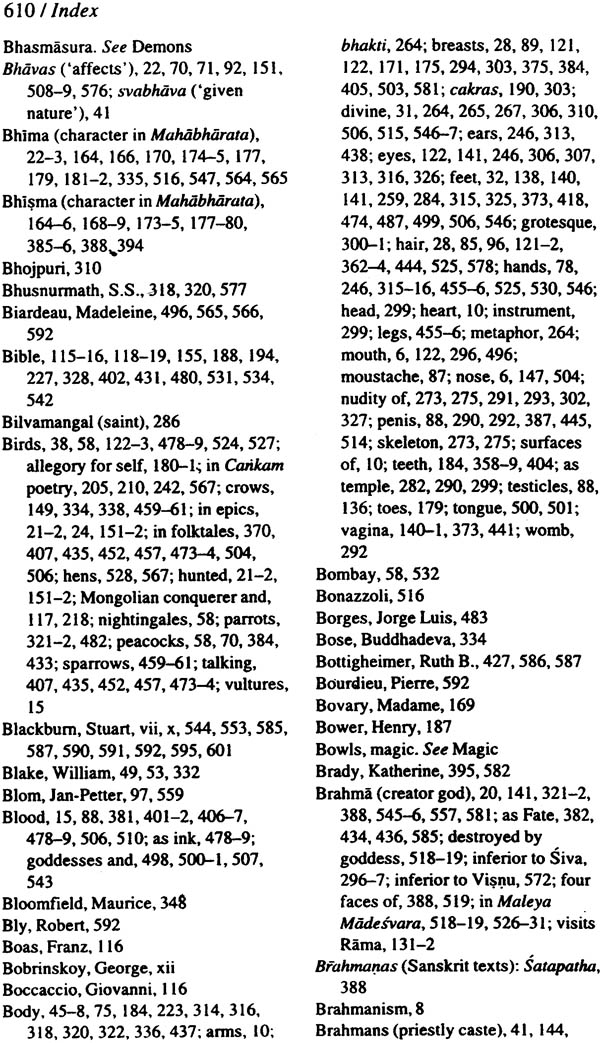
The Collected Essays of A.K. Ramanujan
Book Specification
| Item Code: | NAF651 |
| Author: | Vinay Dharwadker |
| Publisher: | Oxford University Press, New Delhi |
| Language: | English |
| Edition: | 2013 |
| ISBN: | 9780195668964 |
| Pages: | 656 |
| Cover: | Paperback |
| Other Details | 8.5 inch x 5.5 inch |
| Weight | 430 gm |
Book Description
In the last three or four years of his life, A.K. Ramanujan made a series of notes on the various essays on literature and culture that he had been writing for about four decades. He had delivered most of the essays in earlier forms as lectures to audiences in the United States, Europe, and India. He had also published early and late versions of many of them in scholarly journals and edited books since the 1950s. But some of them were still no more than outlines for talks or incomplete working drafts (ha t needed substantial recasting and rewriting. The papers he left behind at his death on 13 July 1993 suggest that he intended to complete some of (lie unfinished pieces, revise the finished ones that were in print or in' typescript, and bring together about thirty-five of them in a thematic arrangement for a possible volume of collected essays.
Late in 1993, Molly Daniels-Ramanujan invited a number of Ramanujan 's colleagues, collaborators and friends to complete what he had contemplated. The present volume is a result of that collaboration, and comes as close as possible to the design he had revealed posthumously in his fragmentary notes. Wendy Doniger reviewed the material for Section I, 'General Essays on Literature and Culture', wrote a short introduction to it. And recommended other pieces for inclusion in the book. John Carman wrote an introduction to the essays on bhakti in Section III, 'Essays on Bhakti and Modern Poetry', while Stuart Blackburn and Alan Dundes selected, re-arranged and introduced the contents of Section IV, 'Essays on Folklore'. Milton Singer, working independently, and Edward Dimock and Krishna Ramanujan, working together, produced two different accounts of Ramanujan's career that serve as a composite introduction to his writing and as tributes to his memory. As the general editor of the hook. coordinated the work of these colleagues, assembled all the essays, prepared the editorial matter, revised the notes and references for uniformity of style, and also provided the introduction to section II, ‘Essays on Classical Literatures’.
This volume now contains thirty essays altogether, six each on general aspects of India literature and culture, classical literatures, and the literatures of the bhakti movement and the modern period, and twelve on the study of India folklore. It excludes the essays that are already famous as part of Ramanujan’s books in print: the After words to The Interior Landscape (1967), U. R. Anantha Murthy’s Samskar at (1976), Hymns for the Drowning (1981), and Poems of Love and War (1985), and the Introductions to speaking of Siva (1973) and Folktales from India (1992). The volume also excludes the lecture-texts and interview-transcripts that are forthcoming in The Uncollected Poetry and Prose, and the drafts and outlines of several lectures and essays on topics in Indian linguistics that are too technical to be of interest to general readers. This edition of his collected Essays thus brings together all the finished scholarly pieces that Ramanujan left behind in typescript or in print, that are not available in his other book-length works, and the he had contemplated including in such a volume.
Of the essays that have appeared in print earlier, we have reproduced the last published versions, incorporating all the further changes that Ramanujan had marked –in keeping with a lifelong habit-on his file copies of the publications. In the case of the four essays that were not published in his lifetime, we have closely followed the last typescript versions in his files, silently correcting obvious typographical errors. For the essays that contain notes and references, we have modified the styles of annotation and citations used in our copy-texts for consistency, and have consolidated all the notes and references at the end of this volume for the reader’s convenience. As the general editor, I have added clearly designated notes in brackets, identifying the copy-texts of the essays and commenting briefly, when necessary, on their textual ‘evolution’. Ramanujan often published an essay many years after he had first drafted or delivered it as lecture, and since the complex sequence in which these pieces were written,, revised and first published affects our response to them and to him now, I have constructed general chronology of his books and essay at the end of this volume. MY observations in the chronology may help us decipher how Ramaujan’s mind revolved around certain them over a long period of time, how it moved from one set of interests or switched from one angle of vision to another, and how it circled back to older concerns after thinking through crucial matters of method and interpretation in the light of his more recent discoveries.
Repetition and variation were persistent features of Ramajujan’s style as a thinker, teacher, poet, and essayist. He embraced strong ideas passionately and held on to them for great lengths of time (until he could replace them with other powerful ideas) , even as he constantly sought our new concepts, new locations, new insights. When he found an intellectual position that sustained all his interests-such as Anglo-American New Criticism in the 1950s, French structuralism, Russian formalism and German critical theory in the 1960s, and 1970s, and some aspects of French deconstruction and American and Indian feminism in the 1980s- he used it as vigorously and comprehensively as possible to elucidate many different texts, genres, and themes. Whenever he discovered the shortcomings of a particular method or perspective (as he did with the structuralism logic of binary oppositions’ in the early 1980s, for example), he approached his material all over agin with a new understanding of their values and meanings. But just as he rarely adopted others’ theories and principles without important modifications of his own, he rarely repeated himself without ringing changes, or producing significant variations, on what he had thought and said earlier. His explications of India literature and culture thus were always in motion, constantly energizing familiar patterns with unexpected new alignment s and rearrangements.
The combination of movement and recurrence that gives a critical edge to the essays in this volume is linked closely to the multidisciplinary and interdisciplinary dimensions of Ramanujan’s scholarship. He approached his topic, no matter what it was, with instruments of analysis from several different disciplines, and ht arguments he developed could not be reduced to he standard arguments in any one of them. His explications of poems, for example, drew as much on the protocols of formalist literary criticism as on the contextual concerns of ethnography, history, and folklore studies, while his explanations of social codes depended equally on social theory, linguistics, poetics, and comparative cultural studies. He negotiated the difficult terrain of multiple, intersecting, and sometimes potentially conflicting disciplines by traversing a helix-like path thorough them, circling around a central axis but never returning to exactly the same position.
Ramanujan moved effortlessly through different disciplines and different types of material (poems, stories, forms, conventions, religions, histories, cultures0 by fashioning a distinctive scholarly style. He designed and wrote his essays so that they would work upon his reads a s much by allusion echo, and suggestion, as by the force of explicit argument. While each piece was structured simply, so that it never strayed far from its stated theme, it was also surrounded by a field of multiple resonances, leading the reader outward in several directions at once. This 'ripple effect' was a function of Ramanujan's poetic style as a writer of critical prose, in which wit, irony, humour and polyphony enabled him to condense several perspectives or insights into a few aphoristic phrases. It was also the result of his pursuit of obliqueness or indirection—the classical Sanskrit device of vakrokti, 'crooked speech'—under the mask of lightness and simplicity. Ramanujan, in fact, constructed an essay much like a poem, which shows more than it tells, suggests more than it reveals, and echoes more than it acknowledges.
Ramanujan succeeded in combining direct topicalisation with indirect articulation because he thought and wrote intertextually. His essays are full of explicit and implicit quotations, and many of them reproduce large portions of other texts, often whole poems and even entire stories. In this proliferation of quoted material, Ramanujan's own commentary frequently takes a back seat, running like a tour-guide's voice in the background, while the objects he discusses keep us fascinated in the foreground. This sort of apparently self-effacing critical intertextuality was central to his scholarly practice because he believed that literary and cultural texts can 'speak for themselves', and speak especially effectively when they are unfamiliar or have been cunningly 'defamiliarised'. For him, the ideal critical essay was the one proposed by Walter Benjamin, where a scholar-critic ought to hide behind 'a phalanx of quotations which, like highwaymen, would ambush the passing reader and rob him of his convictions.' Particularly in the second half of his career, Ramanujan constructed an essay as an 'anthology of quotations', a phrase that also echoes Jacques Derrida's notion of a text as a 'tissue of citations'. Any one of the later critical pieces he wrote was therefore likely to be an 'anthological essay', the text of which emerged out of a series of pretexts, meta-texts, counter-texts, and inter-texts interacting variously with each other.
This book would not have been possible without Molly Daniels-Ramanujan's generosity and patience, and without the promptness and care with which Stuart Blackburn, John Carman. Edward Dimock, Wendy Doniger, Alan Dundes, Krishna Ramanujan. and Milton Singer contributed their expertise at short notice. We regret that Girish Karnad could not join us because of the distances that still separate the United States and India; and that V. Narayana Rao and David Shulman were unable to add their special skills to this editorial effort. We record with deep sorrow that our senior-most colleague, Milton Singer, passed away at his home in Chicago on 4 December 1994, shortly after revising his tribute to Ramanujan for this volume.
I would like to acknowledge a debt of gratitude to the editors and publishers who granted permission to reprint many of these essays; to the University of Oklahoma and its Department of English for their research support; and to Michelle Stie for her diligence and enthusiasm as my research assistant in 1994-95. Molly Daniels-Ramanujan and I owe many thanks to James Nye, South Asia Bibliographer, and William Alspaugh, both at the Regenstein Library, University of Chicago, for their invaluable bibliographical and archival help. Our thanks also to Anuradha Roy and Rukun Advani at Oxford University Press, Delhi, for their tact and patience throughout, their close attention to detail and their skilful overall management of not only this project but also the other books to which it is related: The Oxford Anthology of Modern Indian Poetry (1994), which I co-edited with Ramanujan; Ramanujan's Collected Poems (1995); and his forthcoming Uncollected Poetry and Prose.
A.K. Ramanujan, almost universally known to his associates as Raman, was for many years my respected and always stimulating colleague and friend at the University of Chicago. The essays collected here testify to many themes of that relastionship. Needless to say, his sudden passing in 1993 stunned and deprived us all.
I happened to be the Secretary of the Committee on Southern Asian Studies (COSAS) when he first came to he University of Chicago in 1961. At that time, the present Department of South Asian Languages and Civilizations did not exist; COSAS was his first hole at the University. As with J.A.B. van Buitenen, a Sanskritist, and Edward C. Dimock, Jr., a specialist in the Bengali language and its literature, both of whom had arrived a couple of years earlier, Raman was give a departmental affiliation (in Linguistics) while he became active in COSAS. In this respect, the South Asia language and literature ‘juniors’ differed from their counterparts in Anthropology (e.g. Bernard Cohn, Clifford Geertz, Mckim Marriott), History (Stephen Hay), and Political Science (Myron Weiner) who were directly appointed to their respective departments. Both kinds of ‘junior’, however, soon became active in the programme of teaching and research about South and Southeast Asia; to develop and co-ordinate which COSAS had been orgainsed in 1955.
The unanticipated consequence of this situation was that the ‘juniors’, with their recent specialized degrees in their fields, soon became the mentors of those who had helped to bring them to Chicago. Among these ‘elders’ were George Bobrinskoy in Sanskrit, Robert Crane and Donald Lach in History, Fred Eggan in Anthropology, Edward Shils in Sociology and Social Thought, and myself in Social Sciences and Anthropology.
Another and more important consequence was that the community of scholars which began to emerge as both ‘juniors’ and ‘elders’ talked with one another across departmental, divisional and status boundaries. In 1956, when the College of the University inaugurated three full-year introductions to he civilizations of China, Islam and India, with the assistance of a three-year grant from the Carnegie Corporation of New York, the conversations of COSAS’s community of scholars, including Raman a few years later, became available to undergraduates.
According to all accounts of Rama’s classes and lectures at which versions of some of these essays were presented, confirmed by my own personal observations, the experience was memorable. Beginning often with a provocative question, such as ‘Is there an Indian way of thinking?’, Raman would proceed to present such a diversity of texts and contacts, oral and written tales, poems, interviews and conversations, that the answer to the question would become in escapable, not as a dogmatic assertion, but as an invitation to look at the posed question from a fresh perspective.
My personal conversations with Raman also often turned on some of the questions raised in these essays. These discussions may not have been typical of those he had with other colleagues, yet his comments were so surprising that I may forgive for repeating several.
India’s many language were a frequent subject of our conversations. If I mentioned evidence for India’s linguistic diversity from personal observations or reading , he would not only add illustrations from his own personal household (two mother tongues and two father tongues, as in ‘Telling Tales’), but would also counter with examples from the Untied States. When I once asked him which language in the USA he would consider as a second language after English, he immediately answered, ‘Spanish’.
When we compared western and Indian conceptions of the self, Raman recalled that while he was still at school in Mysore, he noticed a parallel between the Gita and Walt Whitman’s ‘Song of Myself’ in their conception of ‘a double self’, as actor and as object. To my question whether Whitman’s line ‘I am a cosmos’ has a parallel in India, he referred me opt his translation of a poem by the ninth-century saint, Nammalvar, the opening poem in Hymns for the Drowning (1981).
| General Editor's Preface | vii | |
| Introduction: Two Tribues to A. K. Ramanujan | xii | |
| Edward C. Dimock , J R., And Krishan Ramanujan | xiv | |
| I | General Essays of literature and Culture | 1 |
| Introduction By Wendy Doniger | 3 | |
| 1 | Where Mirrors Are Windows: Towards and Anthology of Reflection | 6 |
| 2 | Is there an Indian way of thinking? An Informal Essay | 34 |
| 3 | Towards and Anthology of City Images | 52 |
| 4 | Food for Thought: towards an Anthology of Hindu Food- images | 73 |
| 5 | Language and Social Change: The Tamil Example | 96 |
| 6 | Some Thoughts on 'Non-Western' Classics: with India Examples | 115 |
| II | Essays on Classical Literatures | 125 |
| Introduction By Vinay Dharwadker | 127 | |
| 7 | Three Hundred Ramayana : Five Examples and Three Thoughts on Translation | 131 |
| 8 | Repetition in the Mahabharata | 161 |
| 9 | Classics Lost and Found | 184 |
| 10 | Form in Classical Tamil Poetry | 197 |
| 11 | On translating a Tamil Poem | 219 |
| 12 | From Classicism to Bhakti (with Norman cutler) | 232 |
| III | Essays on Bhakti and Modern Poetry | 261 |
| Introduction By John B. Carman | 263 | |
| 13 | On Women Saints | 270 |
| 14 | Men, Women, and saints | 279 |
| 15 | The Myths of Bhakti: Images of Siva in Saiva Poetry | 295 |
| 16 | Why an Allama Poem Is not a Riddle: An Anthological Essay | 309 |
| 17 | Varieties of Bhakti | 324 |
| 18 | On Bharati and his prose Poems | 332 |
| IV | Essays on Folklore | 345 |
| Introduction By Stuart Blackburn and Alan Dundes | 347 | |
| 19 | The Clay Mother-in-law: A South Indian Folktale | 352 |
| 20 | Some Folkatales from India | 358 |
| 21 | Hanchi: A Kannada Cinderella | 369 |
| 22 | the Indian Oedipus | 377 |
| 23 | The Prince who Married His Own Left Half | 398 |
| 24 | A Flowering Tree: A woman’s Tale | 412 |
| 25 | Towards a Counter-system: Women's Tales | 429 |
| 26 | Telling Tales | 448 |
| 27 | Tell It to the Walls: ON Folktales in Indian culture | 463 |
| 28 | Two Realms of Kannada Folklore | 485 |
| 29 | ON Folk Mythologies and Folk Puranas | 513 |
| 30 | Who Needs Folklore? | 532 |
| Notes and References | 553 | |
| Chronology of select Books and Essays | 597 | |
| Contributors | 601 | |
| Copyright Statement | 603 | |
| Index | 607 |


